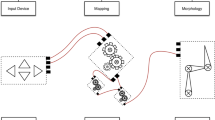Abstract
There is an asymmetry in many tangible interfaces: while physical objects can be used to manipulate digital information, the reverse is often not possible—the digital world cannot push back. We introduce a new push-back tangible technology, a pin-board that physically ejects paper documents. This is realized by extending the Pin&Play technology to support ‘pouts’, addressable pin-like devices that can remove themselves from a board using muscle wire actuators. We describe how this technology has been developed through two iterations of prototyping, application and formative study. An initial study revealed how potential mismatches between the physical and digital characteristics of pouts caused difficulties with users predicting pop-out events and reasoning about the state of pouts. This led us to extend pouts to reveal more of their internal state, an approach verified through a second study. It also raises more general issues for the design of pushback tangible technologies and ubiquitous interfaces.















Similar content being viewed by others
References
Ishii H, Ullmer B (1997) Tangible bits: towards seamless interfaces between people, bits and atoms. In: Proceedings of the CHI 1997, ACM, NewYork, pp 234–241
Moran TP, Saund E, Melle WV, Gujar AU, Fishkin KP, Harrison BL (1999) Design and technology for collaborage: collaborative collages of information on physical walls. In: Proceedings of the UIST 1999, ACM, NewYork, pp 197–206
Klemmer RS, Thomsen M, Phelps-Goodman E, Lee R, Landay JA (2002) Where do web sites come from?: capturing and interacting with design history. In: Proceedings of the CHI 2002, ACM, NewYork, pp 1–8
Pangaro, D, Maynes-Aminzade D, Ishii H (2002) The actuated workbench: computer-controlled actuation in tabletop tangible interfaces. In: Proceedings of the UIST 2002, ACM, NewYork, pp 181–190
Reznik D, Canny J (2001) C’mon Part, do the Local Motion! In: IEEE international conference on Robotics and Automation (ICRA), Seoul, Korea
Rosenfeld D, Zawadzki M, Sudol J, Perlin K (2004) Physical objects as bidirectional user interface elements. IEEE Comput Graph Appl 24(1):44–49
Wrensch T, Blauvelt G, Eisenberg M (2000) The rototack: designing a computationally-enhanced craft item. In: Proceedings of the DARE 2000, ACM, NewYork, pp 93–101
Raffle HS, Joachim W, Tichenor J (2003) Super Cilia skin: an interactive membrane. In: Proceedings of the CHI 2003, ACM, NewYork, pp 808–809
Raffle HS, Parkes AJ, Ishii H (2004) Topobo: a constructive assembly system with kinetic memory. In: Proceedings of the CHI 2004, ACM, NewYork, pp 647–654
Ng Kher Hui, Benford S, Koleva B (2005) PINS push in and POUTS pop out: creating a tangible pin-board that ejects physical documents. In: Proceedings of the CHI, Portland, Oregon, ACM, NewYork, pp 1981–1984
Van Laerhoven K, Schmidt A, Gellersen HW (2002) Pin&Play: networking objects through pins. In: Proceedings of the Ubicomp 2002, Springer, Berlin Heidelberg New York, pp 219–229
How to work with Nitinol: interesting and useful projects you can do with the shape-memory-alloy. http://www.robotstore.com/download/Work_Nitinol_Wire_V13.pdf, verified 28 June 2005
DS2405 Addressable Switch. http://www.maxim-ic.com/quick_view2.cfm/qv_pk/2906, verified 28 June 2005
Overview of 1-Wire and Its Use. http://www.maximic.com/appnotes.cfm/appnote_number/1796, verified 28 June 2005
Acknowledgements
Thanks to Kristof Van Laerhoven, Nicolas Villar and colleagues at Lancaster University and Holger Schnädelbach and Mark Paxton at Nottingham for their help. We are grateful for the support of the EPSRC funded Equator project (http://www.equator.ac.uk).
Author information
Authors and Affiliations
Corresponding author
Rights and permissions
About this article
Cite this article
Ng, K.H., Koleva, B. & Benford, S. The iterative development of a tangible pin-board to symmetrically link physical and digital documents. Pers Ubiquit Comput 11, 145–155 (2007). https://doi.org/10.1007/s00779-006-0065-8
Received:
Accepted:
Published:
Issue Date:
DOI: https://doi.org/10.1007/s00779-006-0065-8




